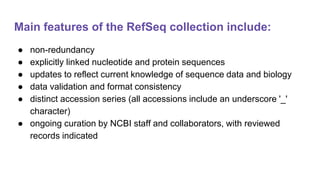Bioinformatics is an interdisciplinary field involving biology, computer science, mathematics and statistics. It addresses large-scale biological problems from a computational perspective. Common problems include modeling biological processes at the molecular level and making inferences from collected data. A bioinformatics solution typically involves collecting statistics from biological data, building a computational model, solving a computational problem, and testing the algorithm. Bioinformatics plays a role in areas like structural genomics, functional genomics and nutritional genomics. It is used for applications such as transcriptome analysis, drug discovery, cheminformatics analysis, and more. It is an important tool in fields like molecular medicine, gene therapy, microbial genome applications, antibiotic resistance, and evolutionary studies. Biological databases are important for organizing













































































































![Example
● Human trypsinogen lineage
● Root: scop
● Class: All beta proteins [48724]
● Fold: Trypsin-like serine proteases [50493]
● Superfamily: Trypsin-like serine proteases [50494]
● Family: Eukaryotic proteases [50514]
● Protein: Trypsin(ogen) [50515]
● Species: Human (Homo sapiens) [TaxId: 9606] [50519]](https://image.slidesharecdn.com/bioinformatics-221023084323-67cafe00/85/Bioinformatics-pptx-110-320.jpg)









































